 SIGN IN
SIGN IN
5 Common Push-up Errors (and how to fix them)
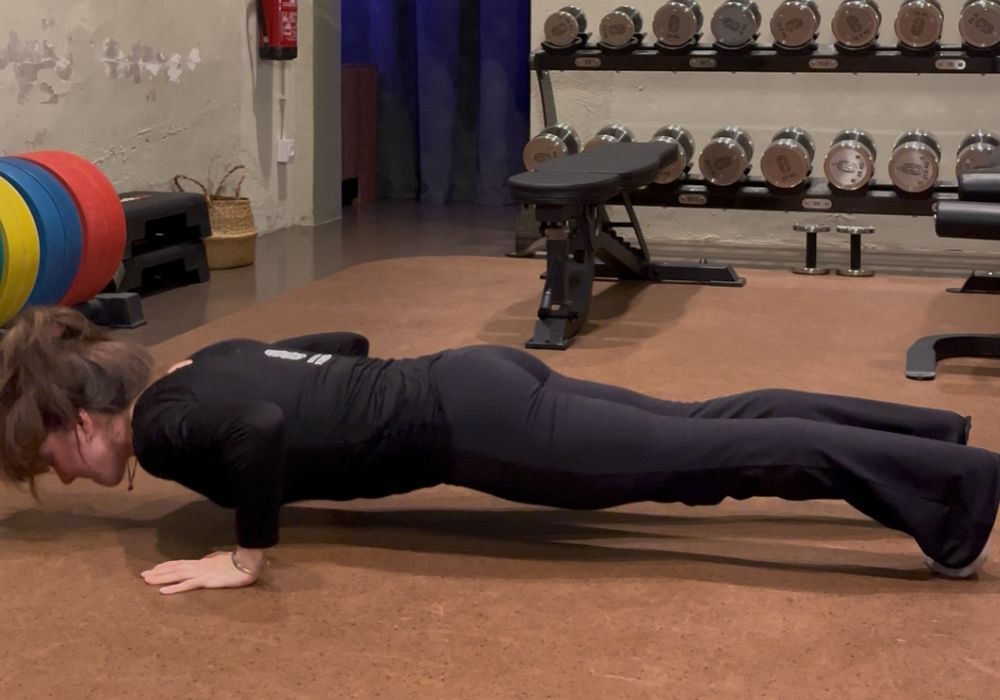
Push-ups are a standard exercise you can do anywhere. Everyone has tried a push-up once in their life. However, most people don’t know how to do them well.
When done right, push-ups are a powerful full-body movement that builds core strength, upper body control, and postural awareness. Done wrong, they can lead to shoulder pain, back strain, and minimal progress.
Here are 5 common push-up mistakes we see all the time and how to correct them so you actually get stronger every rep.
1. Hips Tilted Up (Anterior Pelvic Tilt)
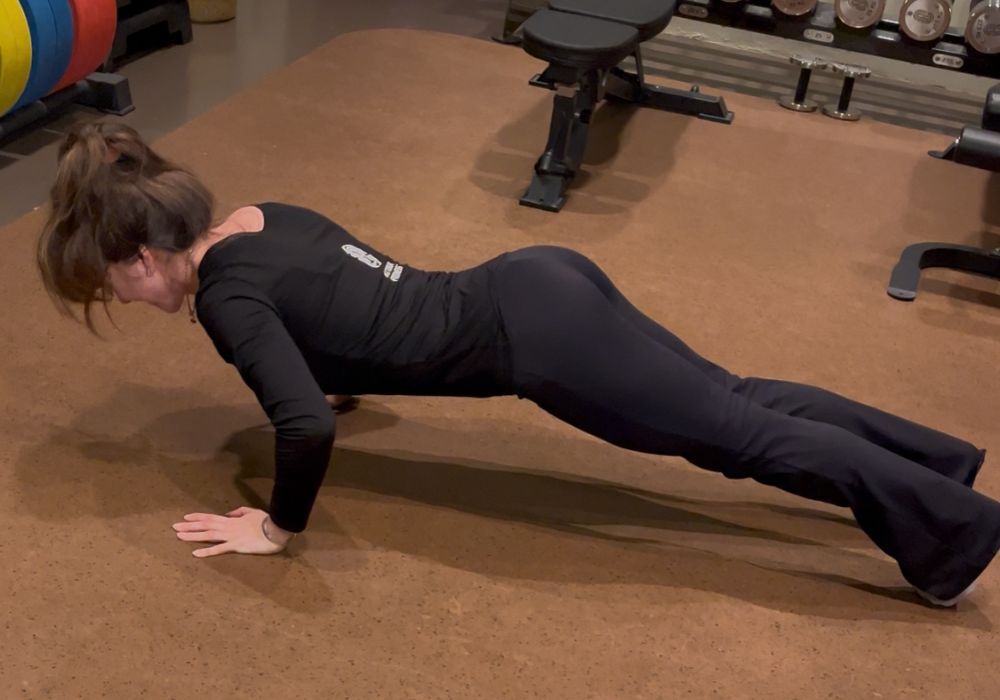
If your bum is lifting into the air as you lower down, you’re likely stuck in an anterior pelvic tilt, where the pelvis tips forward and your core disengages. This breaks the straight line of your body from your shoulders to your feet and would therefore mean a lack of abdominal engagement.
The fix:
Think of “zipping up” your core. Before you even start your push-up, engage your glutes, squeeze your quads, and gently draw your ribs down toward your pelvis. Imagine you’re bracing for someone to poke your stomach - this helps hold a neutral spine and keeps the pelvis aligned.
2. Sunken Hips (Sagging Lower Back)
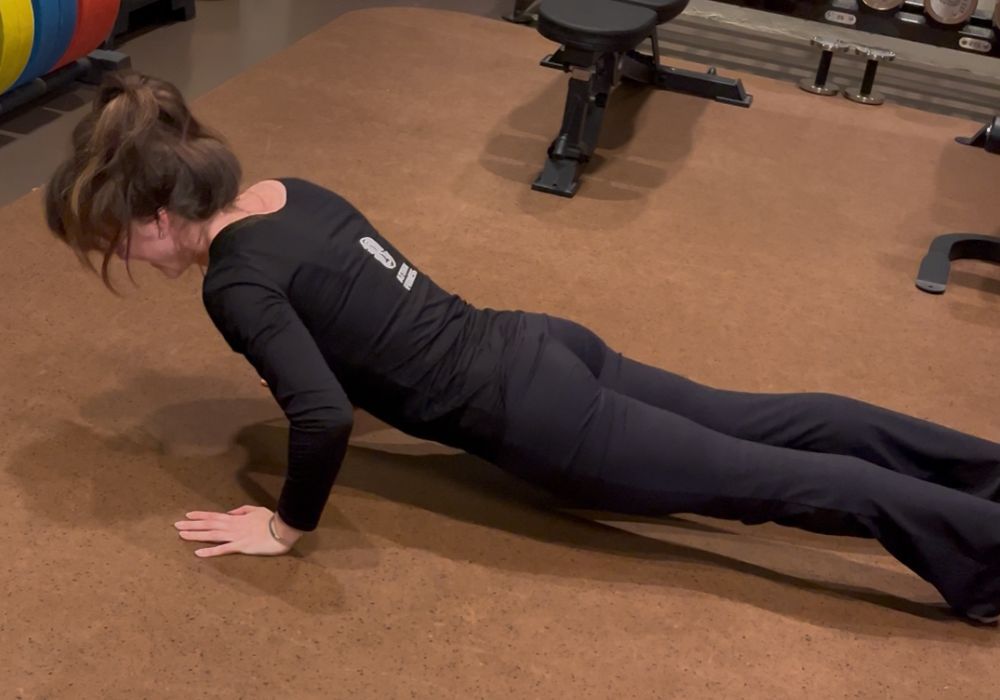 On the opposite end of the spectrum: hips sagging down toward the floor. This usually comes from a tired or inactive core. This puts undue pressure on your lower back and makes the push-up less effective overall.
On the opposite end of the spectrum: hips sagging down toward the floor. This usually comes from a tired or inactive core. This puts undue pressure on your lower back and makes the push-up less effective overall.
The fix:
Go back to the basics of a strong plank. If you can’t maintain a straight line, modify the movement by dropping to your knees and keep the hips aligned with the shoulders. Core tight, glutes engaged, spine neutral.
3. Not Going Low Enough
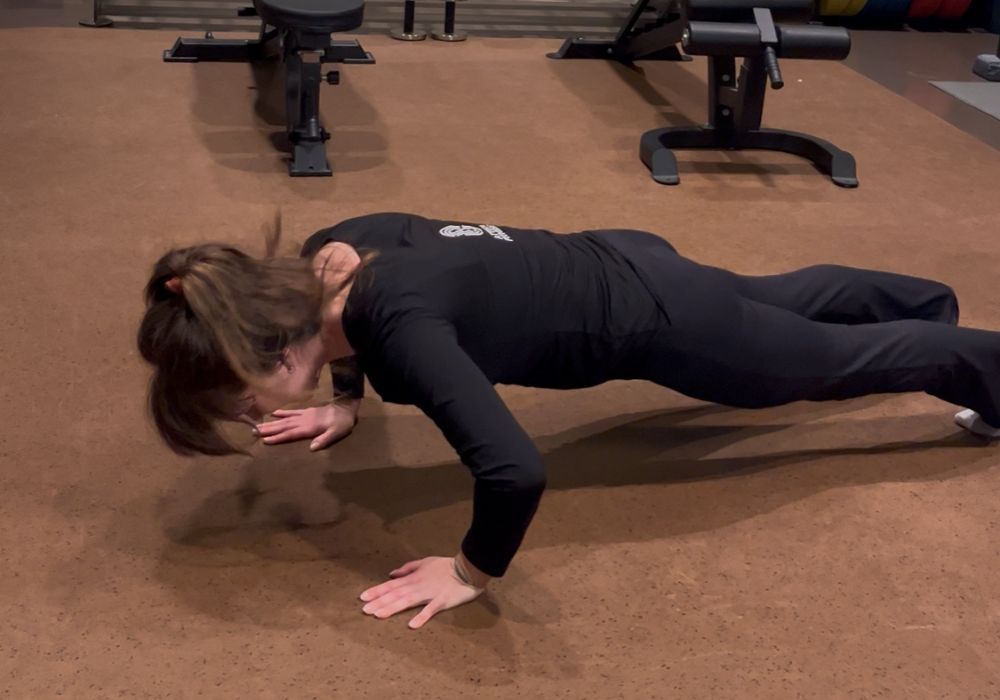
Half reps = half results. If you’re only bending your elbows a little and stopping far above the ground, you're missing the point of the push-up. A full push-up requires your chest to nearly kiss the floor while maintaining control. Otherwise, your chest isn’t working to its potential.
The fix:
Reduce the number of reps and focus on depth. If strength is your limiter, elevate your hands on a box or bench so you can practice the full range of motion without compromising form. The chest, not the belly or chin, should lead the way down.
4. Elbow Positioning: Too Wide or Too Tucked
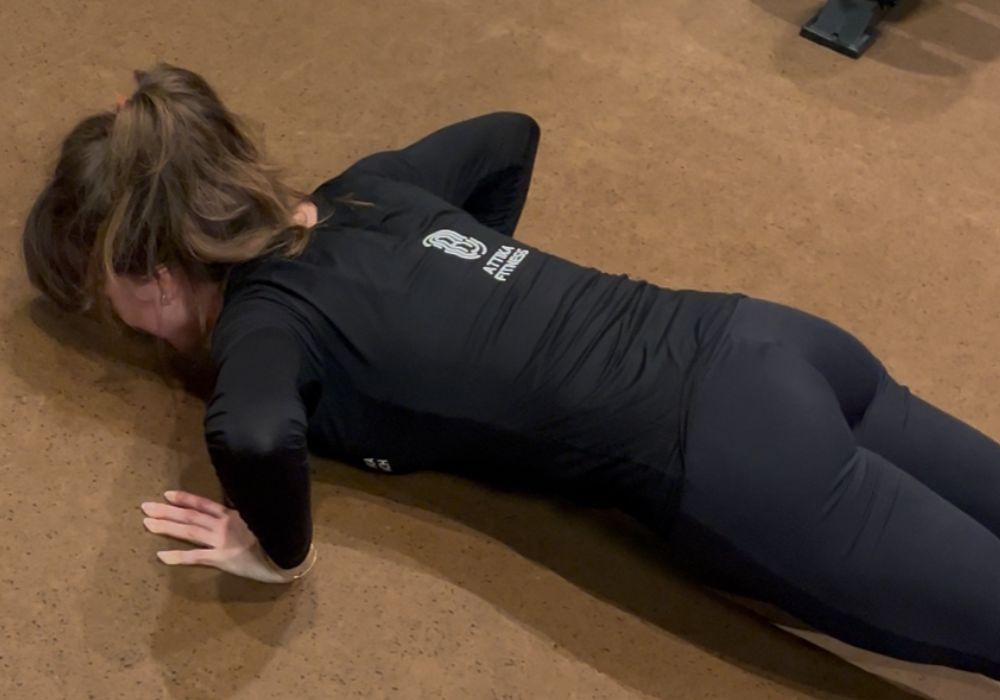
Elbow placement is fairly important to your push-up. If your elbows flare too far out (like a T shape), you're putting your shoulders in a less than favourable position that causes them unnecessary stress and can cause an injury. If they’re tucked too tightly to your ribs, you lose chest engagement and end up doing more of a triceps press.
The fix:
Aim for a 45-degree angle between your torso and your elbows. Think of creating an arrow shape with your arms as you lower. This keeps the shoulders safe and targets the chest effectively.
5. Shoulders Leading the Movement (and Shrugging)
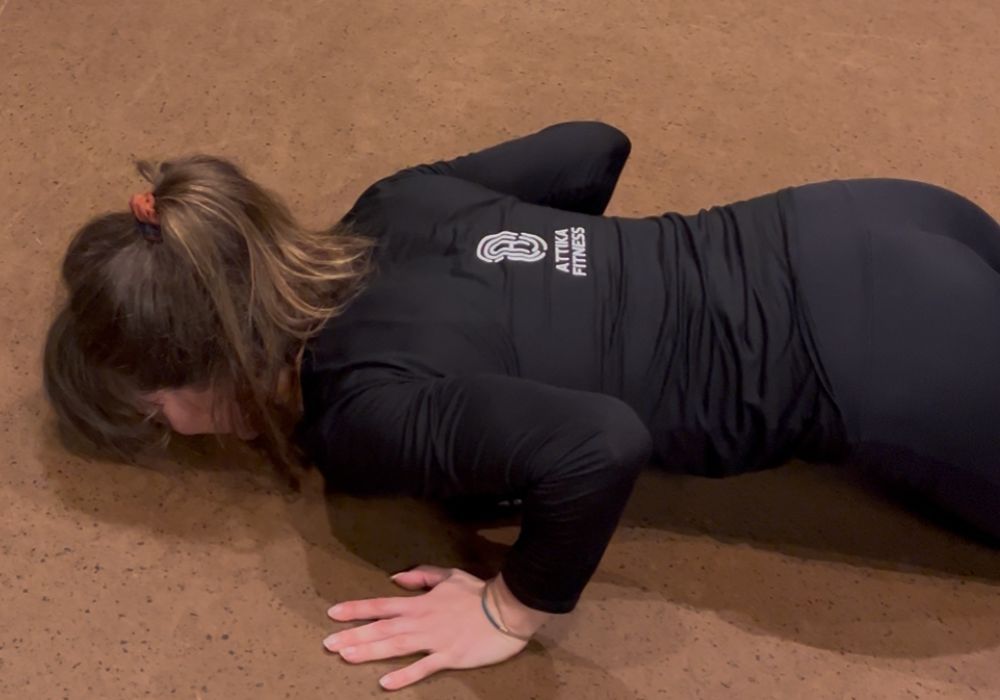
A sneaky mistake that shows up as you fatigue: the shoulders start dropping before the hips—or worse, they creep up toward the ears. This comes from a lack of scapular control and puts the neck and upper traps in overdrive.
The fix:
Retract your shoulder blades slightly and keep them “down and back” throughout the movement. Imagine tucking them into your back pockets. You should feel the lats and mid-back lightly engaged. Practising scapular push-ups - where you move just your shoulder blades without bending the elbows can build awareness and strength in this area.
Ready to try again?
Push-ups are a staple for a reason. When done well, they’re not just an arm workout, they’re a full-body expression of strength and control. But when you rush the reps or overlook your form, you not only limit progress, you risk injury.
If it's too hard to get right, then make it easier. Go on your knees or reduce the incline to perform the push-up on a bench or a wall
Take your time. Get curious about your technique. And remember: at ATTIKA, we’re all about building movement that lasts. Forget your ego, do it right. Strong bodies, smart training.
Push-ups are a standard exercise you can do anywhere. Everyone has tried a push-up once in their life. However, most people don’t know how to do them well.
When done right, push-ups are a powerful full-body movement that builds core strength, upper body control, and postural awareness. Done wrong, they can lead to shoulder pain, back strain, and minimal progress.
Here are 5 common push-up mistakes we see all the time and how to correct them so you actually get stronger every rep.
1. Hips Tilted Up (Anterior Pelvic Tilt)

If your bum is lifting into the air as you lower down, you’re likely stuck in an anterior pelvic tilt, where the pelvis tips forward and your core disengages. This breaks the straight line of your body from your shoulders to your feet and would therefore mean a lack of abdominal engagement.
The fix:
Think of “zipping up” your core. Before you even start your push-up, engage your glutes, squeeze your quads, and gently draw your ribs down toward your pelvis. Imagine you’re bracing for someone to poke your stomach - this helps hold a neutral spine and keeps the pelvis aligned.
2. Sunken Hips (Sagging Lower Back)
 On the opposite end of the spectrum: hips sagging down toward the floor. This usually comes from a tired or inactive core. This puts undue pressure on your lower back and makes the push-up less effective overall.
On the opposite end of the spectrum: hips sagging down toward the floor. This usually comes from a tired or inactive core. This puts undue pressure on your lower back and makes the push-up less effective overall.
The fix:
Go back to the basics of a strong plank. If you can’t maintain a straight line, modify the movement by dropping to your knees and keep the hips aligned with the shoulders. Core tight, glutes engaged, spine neutral.
3. Not Going Low Enough

Half reps = half results. If you’re only bending your elbows a little and stopping far above the ground, you're missing the point of the push-up. A full push-up requires your chest to nearly kiss the floor while maintaining control. Otherwise, your chest isn’t working to its potential.
The fix:
Reduce the number of reps and focus on depth. If strength is your limiter, elevate your hands on a box or bench so you can practice the full range of motion without compromising form. The chest, not the belly or chin, should lead the way down.
4. Elbow Positioning: Too Wide or Too Tucked

Elbow placement is fairly important to your push-up. If your elbows flare too far out (like a T shape), you're putting your shoulders in a less than favourable position that causes them unnecessary stress and can cause an injury. If they’re tucked too tightly to your ribs, you lose chest engagement and end up doing more of a triceps press.
The fix:
Aim for a 45-degree angle between your torso and your elbows. Think of creating an arrow shape with your arms as you lower. This keeps the shoulders safe and targets the chest effectively.
5. Shoulders Leading the Movement (and Shrugging)

A sneaky mistake that shows up as you fatigue: the shoulders start dropping before the hips—or worse, they creep up toward the ears. This comes from a lack of scapular control and puts the neck and upper traps in overdrive.
The fix:
Retract your shoulder blades slightly and keep them “down and back” throughout the movement. Imagine tucking them into your back pockets. You should feel the lats and mid-back lightly engaged. Practising scapular push-ups - where you move just your shoulder blades without bending the elbows can build awareness and strength in this area.
Ready to try again?
Push-ups are a staple for a reason. When done well, they’re not just an arm workout, they’re a full-body expression of strength and control. But when you rush the reps or overlook your form, you not only limit progress, you risk injury.
If it's too hard to get right, then make it easier. Go on your knees or reduce the incline to perform the push-up on a bench or a wall
Take your time. Get curious about your technique. And remember: at ATTIKA, we’re all about building movement that lasts. Forget your ego, do it right. Strong bodies, smart training.
